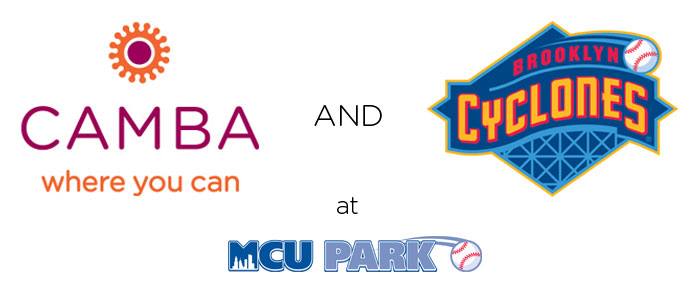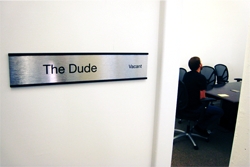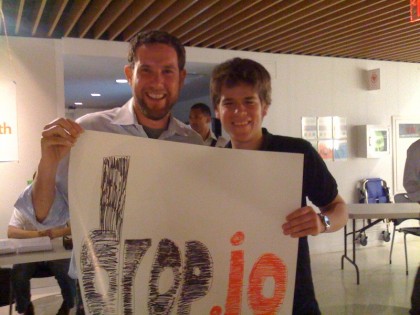If Andrew Dice Clay wears his heart on his sleeve, then his love for Brooklyn is the aorta pumping blood through that heart. And on Saturday, October 1, for the first time in his decades long career, the famously lewd, famously New York comedian will finally come back home. Continue Reading…
Sheepshead Bay ‘Bites’ Less than Blogger Ned Berke Originally Thought
August 10, 2011The last place Ned Berke thought he’d wind up was back home in Sheepshead Bay. Probably the second-to-last place he thought he’d wind up was online, blogging at SheepsheadBites.com about the southern Brooklyn neighborhood where he grew up, covering the news and becoming something of a local celebrity.
“I’ve always had wanderlust,” the 28-year-old Berke said in a recent phone interview. “I’m always on the move. It’s one of the things that’s really killing me about running the site professionally—I can’t ever leave.” Continue Reading…
From the Web
 Do you love baseball and helping other people and feeling good about yourself, all at the same time?
Do you love baseball and helping other people and feeling good about yourself, all at the same time?
Then we’ve got the event for you.
CAMBA, a non-profit agency that provides services to enhance the lives of Brooklyn’s neediest residents, is selling tickets to the Brooklyn Cyclones game on Thursday, July 28, at 7PM at MCU Park. The price for each ticket is $50, and includes not only entrance to the park and a sweet seat for the game, but also a voucher for a hot dog, chips, and a soft drink. And in case that’s not enough, you’ll also get a Brooklyn Cyclones cap, so that you can always display your fierce borough pride! Continue Reading…
From the Web
Mark Stansberry: Riding the Subway to Animation Dreams
June 24, 2011Chances are, you’ve heard his pitch before.
“Good morning, everybody. My name is Mark. I’m a local filmmaker here in the city. I make animated films and cartoons about this litter girl on my t-shirt; her name is Puddin’.”
Everyday, between 6 o’clock in the morning and noon, 46-year old Mark Stansberry rides the subways selling his DVD, which features six short, hand-drawn cartoons, to the people of New York City for, as he puts it, “a small donation of only one dollar.”
He’s right: one dollar is a relatively small donation, next-to-nothing for many subway riders. For Stansberry, it has meant the opportunity to live his dream.
“I have an agent now, and that’s how I met him—on the D train,” he recalled recently over beverages at Café Pedlar on Court Street. Though he fired that agent last week, he noted, “I have somebody else who wants to represent me. I have somebody who wants to manage me. I have somebody who wants to actually market and license the character.”
Six hours a day on the trains over two years has netted Stansberry a distribution deal for Puddin’ with the digital media company The Orchard (he met the CEO on the subway); steady development meetings with NBC since November; and, he estimates, somewhere between $80-90,000 in cold, hard cash.
“When I started the trains, I wanted to make a little money for the films, support myself, buy supplies, and make more films,” he said. “But now it’s about the huge network, and the people, and the audience, and the brand that I’ve begun to build in the last few years.”
One-on-one, Stansberry, who has loved and practiced animation for as long as he can remember, is more low-key than he appears on the train. The tenor of his voice is softer, his diction less sing-songy and rehearsed. But he is no less passionate about Puddin’ today than he was back in 1994, when he created her.
“Earlier in my life I spent a lot of time in church, and got to see a lot of kids, a lot of little girls,” he said. “So I decided to design a character around one particular little girl, who used to always ask me for money and change in church.”
“Puddin’” was his wife’s childhood nickname, and the character, who is a ten-year old African-American girl, lives in a diverse Brooklyn community, though Stansberry never indicates exactly where. The cartoon also features her older brother Nate, her parents, and her best friend Ling, who is Chinese.
Though he was born and bred in Baltimore, Stansberry insists New York has always felt like home. He arrived here at the age of 19 and interned at a few animation studios, which, he says, “allowed me to look over other animators’ shoulders.” The rest, he says, he learned from books, and while he is respectful of technological advancements like 3-D and CGI, Stansberry prefers more traditional animation methods, and draws every single Puddin’ frame by hand.
The cartoons of the 1970s were, in his view, the height of entertainment, and he spoke wistfully about the days when parents and kids enjoyed these shows together. “Sunday nights, as a kid, the whole family would watch ‘The Wonderful World of Disney,’” Stansberry said. “That’s it. Everybody would watch the same thing.”
Talks with NBC have been difficult because they see Puddin’ as a kids’ show, whereas Stansberry thinks it has a wider demographic. “Based on the feedback I get from people,” he said. “It appeals to everybody, and everybody takes something different away from it.”
After years of weekly separation, Stansberry, his wife, and their eight children (four boys, four girls) are finally all under one roof in Williamsburg, Brooklyn. Up until last spring, Stansberry commuted between New York and Baltimore, staying at hostels in the city four days a week and going home on weekends, when he’d burn more DVDs to prepare for the following week’s subway sales.
Stansberry’s time on the trains has molded him into more than just an animator. He is now also a savvy marketing entrepreneur, and a New York City celebrity of sorts, having been featured in various local newspapers and radio programs.
“I don’t have much fear,” he said, but copped to feeling nervous before making his first official pitch on the subway. “I take a lot of risks, as an artist and financially. To me, that was just another risk: to look silly or stupid to some people.”
Most people respond positively to Stansberry’s approach, and he cited the 4 and 5 lines for their particular generosity. He is mindful that his selling tactic might bother straphangers, many of whom would rather be anywhere else at the moment he barges into their lives.
“People are surprised because it’s not the typical, ‘I need help,’ thing,” he said. “I always tell my wife, I wish I could tell people, whether they panhandle or whatever they do…never apologize for being there. That’s the first mistake.”
After all, if he’s learned anything, it’s that New Yorkers are not as hard as they seem. Just don’t tell them he said so.
Check out Puddin’ at Stansberry’s You Tube Channel
From the Web
 Jesse Levitt is almost everything the owner of two hip Brooklyn bars ought to be: offbeat but serious; nerdy but good-looking; creative but down-to-earth. The one thing he lacks, almost entirely? Ego.
Jesse Levitt is almost everything the owner of two hip Brooklyn bars ought to be: offbeat but serious; nerdy but good-looking; creative but down-to-earth. The one thing he lacks, almost entirely? Ego.
Seated in a wooden booth (that sometimes doubles as a stage) in his Prospect Heights watering hole Minor Arcana, Levitt, wearing a green, army-style jacket lined with outspoken pins, commanded nothing like a scary “I’m the boss” vibe on a recent Wednesday evening. Rather than tout the success of the Coney Island-themed Minor Arcana and his other bar Kings County, in Bushwick, Levitt, who moved around a lot before landing in New York City 18 years ago, was brutally honest about the pressures of owning two bars.
“People think I sit around and drink beer all day,” he said, smiling. Minor Arcana does offer 12 brews on tap, but in reality, Levitt’s life sometimes more closely resembles that of a new parent. “You can never really 100 percent just relax, because some issue could come up at any time. I’m always on call.”
In between worrying about emergencies, Levitt manages to make Minor Arcana and Kings County comfortable, low-key, funky places to grab a drink (or four); take in a burlesque show; enjoy a 2-for-1 happy hour between 4-8pm, and also from 12-2am; or partake in a weekly trivia competition. He’s also kicking off a new party at Minor Arcana on the second Thursday of every month, called Tranz X. It will feature go-go boys and “boy-lesque” performances, and will be, Levitt thinks, one of the only bar events for the gay community in Prospect Heights.
His goal as a bar owner, he said, is simply to keep his establishments “an honest place to have a good time,” and he’s not worried about Minor Arcana being seen as one particular kind of bar or another. “If it’s thought of as a gay-friendly bar, that’s fine with me,” Levitt said.
He thinks that holding numerous events helps his bars stay relevant, and is one of many lessons he’s learned in the three-and-a-half years since he left the finance world to take over Kings County from its previous owner.
“It was like a private club for this guy and his friends,” Levitt said, noting that it has a decidedly different vibe from Minor Arcana. And though both of his bars are in up-and-coming hipster enclaves, Levitt insists he’s not riding any sort of trend. “I like this area because when I first started evaluating places, there were only half the number of bars that are here now,” he said of Prospect Heights.
 As Minor Arcana approaches its first anniversary, Levitt reflected on the run-up to its debut, and one ominous trip to a Coney Island fortune teller. “She told me not to open this place, and to hold off,” he said. “I went ahead and did it anyway.”
As Minor Arcana approaches its first anniversary, Levitt reflected on the run-up to its debut, and one ominous trip to a Coney Island fortune teller. “She told me not to open this place, and to hold off,” he said. “I went ahead and did it anyway.”
And did it with a Coney Island theme, to boot; not tempting fate, exactly, but rather as an homage. “Coney Island is a timeless—at least for New York City—place to go and have fun,” Levitt said.
In a way, that’s what he’s tried to create in Minor Arcana. The space is small but ample, with deep lavender walls covered by a handful of framed, retro-style Coney Island advertisements. The bathroom, adorned with rows of tarot cards, is a tribute to Levitt’s (so far) inaccurate fortune, and to the bar’s name: in tarot readings, the minor arcana cards represent the concerns, activities, and emotions of everyday life.
But the real treat at Minor Arcana is its custom-designed, shatterproof glass bar containing a series of dioramas that can be viewed and enjoyed from above. That the rotating, miniature art installations have stirred conversations and debate is no accident, because despite his passive demeanor, Levitt’s thoughtful, even-keeled fingerprint is all over his establishment.Be on the lookout for Levitt and his understated kitsch at this year’s annual Coney Island Mermaid Parade on June 18, which, as luck would have it, coincides with Minor Arcana’s one-year anniversary.
“We’re going to sponsor a float, and have an after-party at both bars, with a shuttle bus between both bars, with a bartender and go-go dancers,” he said, getting excited, both at the idea of a party and of shoving it in fate’s face.
And why not? After all, Levitt’s only regret, he says, is probably similar to that of his many loyal patrons: “Probably those times I’ve had too much to drink,” he said, soberly.
From the Web
If the décor of Etsy’s headquarters in DUMBO is any indication of what shoppers can find on its extremely popular website, then those in search of an octopus arm sculpture are in luck.
Billed as the only marketplace for buying and selling handmade goods online, Etsy was founded in 2005 by Rob Kalin, Chris Maguire, and Haim Schoppick with the motto “Buy, Sell, and Live Handmade.” Adam Brown, Etsy’s public relations manager, explained why the site is preferable to eBay for a particular kind of consumer.
“I view eBay as more of like a garage sale or a flea market where you’re always trying to get the lowest price,” he said, seated in a conference room meant to look like the inside of a spaceship, I think. “It’s like looking in somebody’s junk drawer of stuff, whereas if you come to Etsy, you’re looking at things that are handmade.”
Etsy shoppers will also find craft supplies on the site, as well as vintage goods, which are defined as items older than 20 years. They depend on consumers to flag potentially illegitimate objects, and the customer support team then investigates the claim.
“We rely on those people in a way to help us maintain the integrity of the marketplace,” Brown explained. Etsy is nothing if not eclectic, a fact reinforced with a single glance around the office space, which was among the largest and most colorful I’ve seen in my travels around Digital DUMBO (aka NY Digital District).
Initially run out of an apartment in Ft. Greene, Etsy relocated first to an office at Flatbush and Myrtle Avenues, and then on to DUMBO. Staying in Brooklyn was important not only because so many employees live in the borough, but because it felt like home. Oh, and there are creative types nearby. Lots of them.
“We take a great deal of pride in it,” Brown said of Etsy’s DUMBO base. While it’s technically a digital company, Brown thinks Etsy has little in common with the myriad marketing/social media/advertising/graphic design agencies in the neighborhood.
“We just came here more because of the creative side of it than the digital side,” Brown stressed. “I think that wasn’t as important to us as the fact that there are actual artists studios.”
He conceded that being in DUMBO has helped with recruitment, because potential hires want to live in Brooklyn and are aware of the digital opportunities in DUMBO. Etsy employees receive one hundred dollars to spend on the site to decorate their workspace, and while most workers are technologically savvy, the typical Etsy seller need not be.
“Creating an Etsy account is about the same as setting up a Facebook account,” said Brown, because all the user needs to do is input copy and upload pictures. “Obviously the more you are willing to learn about stuff…the greater your chances for success.”
Available for purchase on Etsy are items ranging from earrings to blankets; dresses to pillows; miniature pumpkins to tutus for newborns, all handmade. And buyers can search for items by color, by seller location, by editor’s picks, or by something called “time machine,” that I was frankly too nervous to click on.
The site’s users are overwhelmingly female, and while Brown said they market to men, the ladies have been plenty kind to Etsy, which recently opened up a satellite office in Berlin as part of an effort to enhance its international presence.
“We’re hoping to do a lot more with the idea of social commerce, which means instead of searching for a scarf, there would be more tools to help you find a scarf that would have to do with other people,” Brown said.
Etsy gets 700 million page views a month, and the company is bigger than most in DUMBO, with around 100 employees in the office and a smattering of people around the country who work from home. It’s possible some of them know the derivation of the word “Etsy,” but Brown, for one, wasn’t telling.
“I kind of stopped answering [that question],” he said when I innocently asked what Etsy means. He instructed me to look it up (I did, and found only speculation), and then pick my favorite definition. So let’s go with this: Easy To Sell Yourself.
Which can be interpreted any number of ways.
Source: Brooklyn Heights Blog » Brooklyn Tech
http://brooklynheightsblog.com/archives/21417
From the Web
At 11 years old, Brooklyn Digital Foundry is a dinosaur by DUMBO standards. But this self-described “old guard” of the industry remains on the cutting edge of traditional and digital marketing, thanks to the passion of founders Brian Lemond and John Szot, both trained architects in their late 30s who met at the University of Texas.
 “We’ve always taken pride in that even though we do marketing materials for other people, we’ve never done marketing materials for ourselves,” Lemond said recently, sitting at a conference table in the Foundry’s white-walled Jay Street office. “Our reputation has been the thing that’s driven this business.”
“We’ve always taken pride in that even though we do marketing materials for other people, we’ve never done marketing materials for ourselves,” Lemond said recently, sitting at a conference table in the Foundry’s white-walled Jay Street office. “Our reputation has been the thing that’s driven this business.”
It’s a business that continues to grow, having recently spun off Brooklyn United, an arm of the company that focuses specifically on art and creative direction instead of concise brand marketing products, like websites, brochures, or business cards. Szot believes this has been the most efficient way of marrying broad ideas with the finer points of execution.
“We usually see the project from the beginning all the way to the end of production,” he said, noting that their wide variety of clientele—from artists and architects to education institutions and fashion houses—makes it worth walking through the door every morning. (The killer view of the Manhattan skyline probably doesn’t hurt either.)
 Szot and Lemond first operated Brooklyn Digital Foundry out of an apartment on Henry and Atlantic Streets in Brooklyn Heights, and moved around a few times before settling in DUMBO two years ago. They have just eight people on staff, allowing them to remain extremely involved in all aspects of a project.
Szot and Lemond first operated Brooklyn Digital Foundry out of an apartment on Henry and Atlantic Streets in Brooklyn Heights, and moved around a few times before settling in DUMBO two years ago. They have just eight people on staff, allowing them to remain extremely involved in all aspects of a project.
As for why their company and many other digital houses have been relatively immune to the downturn in the rest of the economy, Lemond cited the Foundry’s project-based business model, which he said makes them less vulnerable to market shifts.
Their workload, he said, includes projects “that are already funded, already focused, that have to be developed and completed regardless of the external economy.” Larger advertising houses tend to be account-based, and in bad financial times, accounts are often truncated or yanked altogether.
Neither Lemond nor Szot, both tall, slim, and baby-faced despite splashes of gray hair on their heads (Szot) and in their stubble (Lemond), would say that the Foundry’s small stature allows them to better know their business and be more successful. Instead, they chalked it up to flexibility and diversity of services.
“It’s a grab bag of things people might need,” Lemond said. “Everything from creating assets like photography and video direction and production, all the way to full website development and graphic design, both for traditional and new media.”
The Foundry’s range of capabilities is a bit of an anomaly in DUMBO, where companies often hone in tightly on one specific market or skill. But instead of looking at each other as competitors, the 60 or so digital companies that call DUMBO home are, it seems, each other’s biggest fans.
“Most of the people who run these businesses have grown up and matured through learning from other open, like-minded people,” said Lemond. “So I think there’s a respect for that as a position, and a way of engaging your professional peers.”
And nowhere is this more evident than in Lemond’s work, along with Mike Germano of Carrot Creative and Sam Lessin of drop.io, to re-brand DUMBO as the New York Digital District, a distinction that Lemond insists would promote unity among the companies already there while simultaneously drawing others to invest in the area.
 Though he was reluctant to offer advice to anyone thinking of starting a digital agency that could someday land in DUMBO, Lemond is uniquely positioned to do so, having created, along with Szot, a lucrative formula.
Though he was reluctant to offer advice to anyone thinking of starting a digital agency that could someday land in DUMBO, Lemond is uniquely positioned to do so, having created, along with Szot, a lucrative formula.
“In the early years of our business, we reinvented the wheel every time we turned around, rather than relying on the kind of institutional knowledge that’s out there,” he said after much deliberation.
Lemond noted the overuse of clichés by people in his position, and ultimately settled on something more suitable to his own experience. “Do the things you know,” he said. “But let the things you know be softly defined.”
Works for us. And, obviously, for Brooklyn Digital Foundry and Brooklyn United.
Source: Brooklyn Heights Blog » Brooklyn Tech
http://brooklynheightsblog.com/archives/19353
From the Web
 If it is possible for a person to sit in a chair and bounce off the walls at the same time, then that is exactly what Mike Germano (@mikegermano) did on a recent Monday evening in the DUMBO spot ReBar. But his energy is channeled in the right direction: toward his company, Carrot Creative, and the Digital DUMBO scene, which he has helped cultivate.
If it is possible for a person to sit in a chair and bounce off the walls at the same time, then that is exactly what Mike Germano (@mikegermano) did on a recent Monday evening in the DUMBO spot ReBar. But his energy is channeled in the right direction: toward his company, Carrot Creative, and the Digital DUMBO scene, which he has helped cultivate.
At just 28 years old, Germano, who grew up in New Jersey and now lives in the Financial District, is a pretty accomplished guy. He served a term as city councilman in Hamden, Conn., from 2005-2007, during which time he founded Carrot Creative, a new media marketing agency specializing in social media.
“We help brands build on social networks, and teach them and help them in great ways for them to have conversations with their customers and really turn brands into people,” he explained. Some of those brands include Crayola, the NFL, Disney, Ford, and the Islands of the Bahamas.
When Germano speaks of his achievements, it’s as if wild success was always in the stars. In high school, he and one of his future business partners, Chris Petescia, built websites that he described as early versions of blogs and social networks. In college at Quinnipiac, Germano furthered his ambitions with Robert Gaafar, who would become Carrot’s other partner, creating sites that helped students sell books and rate professors.
“For me, the Internet was a way for me to break the rules and get my message out there,” said Germano, who wanted me to point out that he was not wearing a hooded sweatshirt, opting instead for a pink gingham shirt and khaki pants.
“Every marketing and business class we took, no one was talking about this,” Germano said of harnessing the Internet’s powers. “We knew it was the future.”
At Carrot Creative, which he claims was the first agency to use social networking in 2005, Germano and his team of 15 feel they can truly influence culture by sustaining brands. He shot down the notion that large advertising or marketing houses (some of which have tried to buy Carrot) could ever adequately perform the same services.
“When all these big companies try to hire people to head up their social media, they have no idea what they’re talking about,” he said boldly, pounding on the table a few times, as he did throughout our chat. “I know that fundamentally, they will fail.”
The decision to relocate to DUMBO from Connecticut in 2007 was a simple one for Germano and his partners. They briefly considered Union Square, but felt Manhattan, as he put it, “has a bit of an identity crisis, because there’s so much going on there.”
DUMBO, on the other hand, “was this little oasis of digital.” And once he realized there were so many other startups like his in the region, Germano’s inner politician was stirred to bring people together. He and several others formed the Digital DUMBO monthly meet-ups, which have been going strong—and growing strongly—for more than a year.
Not long ago, Germano joked to pals Sam Lessin of Drop.io and Brian Lemond of Brooklyn Foundry that DUMBO should be declared New York’s “Digital District,” to give themselves and others a louder voice, and it has turned into a genuine crusade.
“We appreciate the individual nature of small companies,” he said. “We need to show them they’re not alone, there’s help out there, and that it’s ok for Manhattan ad firms and brands to bring their money here to DUMBO.”
Which is exactly what they’ve been doing, at least as far as Carrot Creative is concerned. Germano now regularly finds himself turning down business, either because he doesn’t believe in the brand or because it’s not a good fit. But with so many digital companies saturating the neighborhood, is DUMBO starting to feel…a little crowded?
“Competition is always a good thing for the industry,” Germano insisted. “I would rather that. I think in the long run it’s beneficial to me as a company if all the best and brightest agencies that are my competition move tot he same geographic region as me.”
He strongly rejects the notion that digital is over-hyped, saying it’s “in a beautiful exploration stage of both users using it and brands understanding it.” Of course, no matter how harmonic the interplay, Germano understands one thing very well.
“Money speaks volumes,” he admitted.
Though he’s tinkering with the idea of “inevitable” overseas expansion, Carrot Creative and its bright orange couch are in DUMBO for the long haul, which seems advantageous to both parties. Because if the outlook of at least one other person in DUMBO is as sunny as Germano’s, everybody is going to be just fine.
“Digital is the biggest, most important part of having an amazing future in our country,” Germano said, without a hint of hyperbole. Who wants to argue with that?
Source: Brooklyn Heights Blog » Brooklyn Tech
http://brooklynheightsblog.com/archives/18448
From the Web
 You know you’re in Brooklyn, or more specifically in DUMBO, when the conference room at a hugely successful digital marketing and advertising firm is nicknamed “The Dude,” after Jeff Bridges’s immortal character in “The Big Lebowski.”
You know you’re in Brooklyn, or more specifically in DUMBO, when the conference room at a hugely successful digital marketing and advertising firm is nicknamed “The Dude,” after Jeff Bridges’s immortal character in “The Big Lebowski.”
Pontiflex co-Founder and CEO Zephrin Lasker, 38, exudes a similarly laid back vibe. Seated at The Dude’s conference table (bought on Craigslist), he seems at peace in their DUMBO office, which is essentially one large, white-walled room that glimpses the Manhattan skyline. Lasker and his jeans-clad employees are devoted to building, refining, and selling a unique online advertising concept called CPL, or cost-per-lead.
I had absolutely no idea what that meant, but it turns out I’m not alone. “How do I explain to my mom what I do?” a giggling Lasker said he often asks himself.
Despite the fancy moniker, CPL is a fairly no-nonsense approach to advertising. “We are building a system for advertising that lets advertisers buy ads, and only pay for those ads if someone opts in,” Lasker said, leaning back in his chair, hands clasped over his head.
 An example: Pontiflex places ads for Huggies on a website like BabyCenter.com. Within the ad is a space to enter a valid e-mail address to sign up for a newsletter for moms. You see the ad, you sign up, Huggies pays, and never once do you navigate away from BabyCenter.com. Companies typically pay $1.25-$2.00 per sign up, but rates vary, and the fee for an ad is split between the host site and Pontiflex.
An example: Pontiflex places ads for Huggies on a website like BabyCenter.com. Within the ad is a space to enter a valid e-mail address to sign up for a newsletter for moms. You see the ad, you sign up, Huggies pays, and never once do you navigate away from BabyCenter.com. Companies typically pay $1.25-$2.00 per sign up, but rates vary, and the fee for an ad is split between the host site and Pontiflex.
Cost-per-lead, or as Lasker calls it, cost-per-sign-up, differs from traditional advertising models where advertisers pay for eyeballs only. Pontiflex offers “contextual targeting,” meaning they place ads to sign up for the ASPCA on websites like Dogtime.com, where it’s safe to assume users are interested in animal rights.
The idea for this sort of advertising came to Lasker, a Red Hook resident by way of Baltimore and Chile, when he was working at big ad agencies in the early days of performance advertising on the Internet. But the technology required to implement Lasker’s plan wasn’t yet available.
With the help of “a really big tech team” and some venture capital, Lasker and his co-founders developed the data transfer engine they needed. Pontiflex launched in 2008, and is the first company to use CPL. Their system is in high demand by ad agencies and other institutions around the country, and Lasker claims they have no direct competitors.
“We’ve gotten big pretty fast,” he said sheepishly. “It’s a little scary.”
As for whether this brand-specific advertising model will ever be applied in other mediums, like television or radio, Lasker smiled coyly and said only that Pontiflex is doing some research that he can’t really talk about.
Having started two other companies, Lasker was familiar with the “boot camp mentality” of New York startups. “You get run over in the city pretty fast if you’re not progressive,” he said. “I think it forces you to really do a lot in very little time.”
Pontiflex, which tripled its revenue last year, certainly followed that ethos. So did many other DUMBO-based digital outfits, whose success Lasker attributes, at least in part, to their “blank slate” of a neighborhood.
Brooklyn, in his view, is “hip, but it’s totally scrappy,” much like startups themselves. “We’re not going to have wood paneled offices and drive around in fancy town cars,” Lasker continued. “It’s more entrepreneurial.”
Lasker is no tech-whiz, but he regards the “geek” stereotype as a badge of honor. “For me, it means you think kind of differently, you don’t necessarily fit in,” he said. “And with a startup, that’s great.”
Given the rampant optimism in his industry at present (as witnessed by this reporter and detailed in last week’s New York Magazine cover story), Lasker confessed there’s at least one negative aspect of this booming field.
“There’s a lot of hype,” he said. And while hype can be good, it can also lead to backlash. “You have to be careful. Sometimes there’s just a lot of smoke.”
Source: Brooklyn Heights Blog » Brooklyn Tech
http://brooklynheightsblog.com/archives/18024
From the Web
 Steven Greenwood (@sgreenwood) rarely stops smiling when talking about drop.io, the two-year old, DUMBO-based company that, in a nutshell, powers content sharing online. It could be that Greenwood, who is 32, is enthusiastic about what he does as vice president of business development at drop.io, which recently spun off a service called PressLift that Greenwood created; or maybe he’s chipper because Brooklyn Borough President Marty Markowitz just announced that his office is going to start using PressLift for all of its media needs. Whatever the reason, Greenwood’s positive outlook on his industry is not only echoed by his peers, it is refreshing in an otherwise dour economic climate.
Steven Greenwood (@sgreenwood) rarely stops smiling when talking about drop.io, the two-year old, DUMBO-based company that, in a nutshell, powers content sharing online. It could be that Greenwood, who is 32, is enthusiastic about what he does as vice president of business development at drop.io, which recently spun off a service called PressLift that Greenwood created; or maybe he’s chipper because Brooklyn Borough President Marty Markowitz just announced that his office is going to start using PressLift for all of its media needs. Whatever the reason, Greenwood’s positive outlook on his industry is not only echoed by his peers, it is refreshing in an otherwise dour economic climate.
“We’re actively hiring!” he exclaimed, sitting in a Union Square diner sipping a soda on a recent evening.
Greenwood believes New York City is the epicenter of the next phase of the internet revolution. “We could not have built PressLift in any other city in the world,” he said. “We’re within a subway ride away from the top PR firms, the media companies, Madison Avenue, and big Fortune 500 companies who we can connect to in a single day.”
PressLift would not have happened without the success of drop.io, which Greenwood described as “a point of exchange on the internet.” Teachers, journalists, architects, and thousands of others use the site to create “drops,” a means of online file-sharing. The service is free up to 100 megabytes, after which point users pay for more space.
The benefit of drop.io for people working on a project together, for example, is that it streamlines communication. Instead of engaging in a long e-mail thread, each member of the team receives an alert when content is added to or changed in the “drop.”
“These are real time points of exchange,” said Greenwood, who lives in the East Village. It is drop.io’s responsibility, he added, to not only use their robust background to power content sharing, but to provide context and relevancy. “We’re building specific applications that are geared to specific users for certain uses.”
Case in point is PressLift, the genesis of which happened very organically. “Among the tens of thousands of users of ‘drops’ were communication professionals,” said Greenwood. “What they wanted to do was share multimedia with a press release—really, a very simple idea. It was actually really hard to do in practice.”
But they worked it out, creating a device for public relations professionals or press departments at places like the Borough President’s office to use to combine the text of a press release with associated video, audio, pictures, or links.
When asked why the Borough President’s office should use PressLift instead of simply creating their own page for that sort of content, Greenwood employed a helpful analogy.
“If you’re an individual company you constantly have a decision: do we buy a desk or do we build a desk?” he said. Using PressLift, which has access to the resources and talent from drop.io, is akin to buying the desk, because, Greenwood added, “We know content sharing really well.”
Drop.io/PressLift also works with Pepsi, Conde Nast, McGraw-Hill, and the Robin Hood Foundation, whose offices Greenwood was headed to later for a meeting, dressed predictably in—what else?—a zip-up hooded sweatshirt.
Greenwood sees DUMBO’s role as a breeding ground for digital start-ups much like some kids see Disney World. “It’s an area where you can imagine,” he said dreamily. “A lot of what we’re doing is trying to imagine where the future is.”
Though DUMBO is historically known for its population of artists, Greenwood doesn’t see himself or his contemporaries as all that different from their progenitors.
“This is a place that encourages and fosters ideas, and helps create this community that promotes them,” he continued. “That’s incredibly valuable, and it’s part of this ecosystem growing in DUMBO, and Brooklyn, and throughout New York.”
Drop.io will host the 15th Digital DUMBO meetup on Thursday, April 29, at their offices in, duh, DUMBO.
Source: Brooklyn Heights Blog » Brooklyn Tech
http://brooklynheightsblog.com/archives/17811





